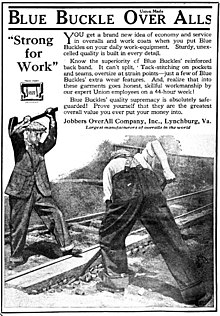 A construction worker wearing overalls | |
| Type | protective clothing |
|---|---|
Overalls or bib-and-brace overalls, also called dungarees in British English,[1] are a type of garment usually used as protective clothing when working. The garments are commonly referred to as a "pair of overalls" by analogy with "pair of trousers".[2]
Overalls were originally made of denim, but they can also be made of other materials such as corduroy, chino cloth, or leather. Overalls were invented in the mid to late 1890s by Grace Howard and Jacob W. Davis at Levi Strauss & Co., but they went through an evolution to reach their modern form.[3] Initially created to serve as protective clothing during physically demanding work, they have since also become a fashion garment.[4] Many high-fashion brands have released their own spin on overalls.[5] Today, overalls can still be found in some workplaces, while also being worn casually by all kinds of people.

- ^ "dungaree". Oxford English Dictionary (Online ed.). Oxford University Press. (Subscription or participating institution membership required.) 2, 3. Quote: "dungaree, n.: 3. In plural. Originally British. A type of overalls consisting of trousers with an extra piece of cloth covering the chest, held in place by a strap over each shoulder; (later also frequently) a casual garment resembling this, usually made from denim, corduroy, or heavy cotton, and typically worn by women or children. The usual sense in British use and in most varieties of English close to British English. In North America known typically as bib overalls or overalls, and in Australia as overalls."
- ^ "Walton & Taylor "The History of Overalls (Jeans)"". www.waltontaylor.com.
- ^ Kyi, Tanya Lloyd (2011). The lowdown on denim. Hanmer, Clayton. Toronto: Annick Press. ISBN 978-1-55451-415-1. OCLC 825770364.
- ^ "Christian Dior Fall 2017 Ready-to-Wear Collection – Vogue". www.vogue.com. March 3, 2017.
- ^ MacDonall, Nancy (May 6, 2021). "Skinny Jeans, Move Over: Overalls Are Here (Again)". The Wall Street Journal.